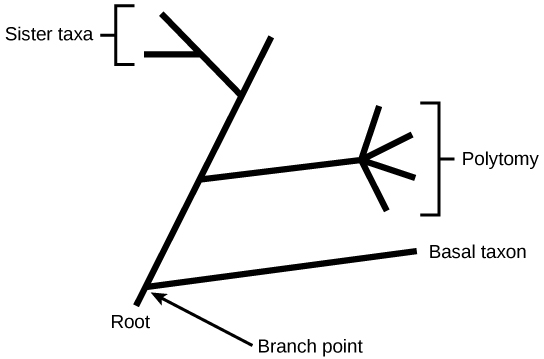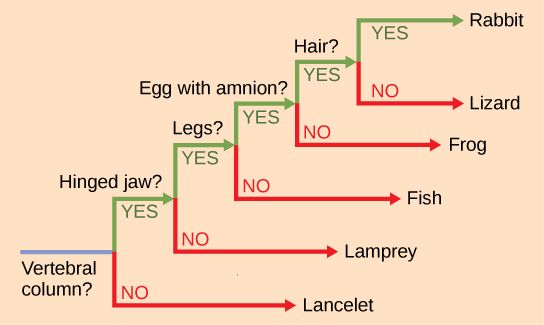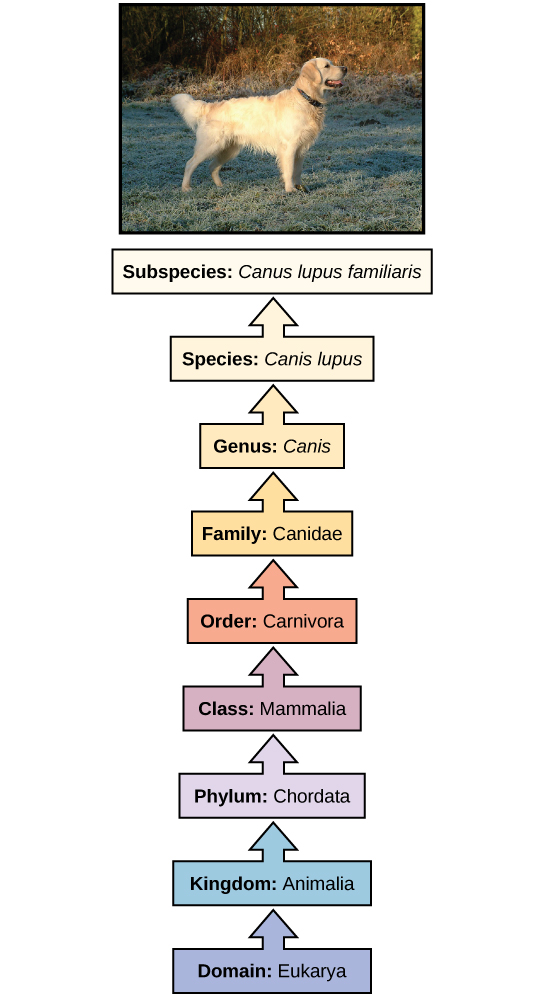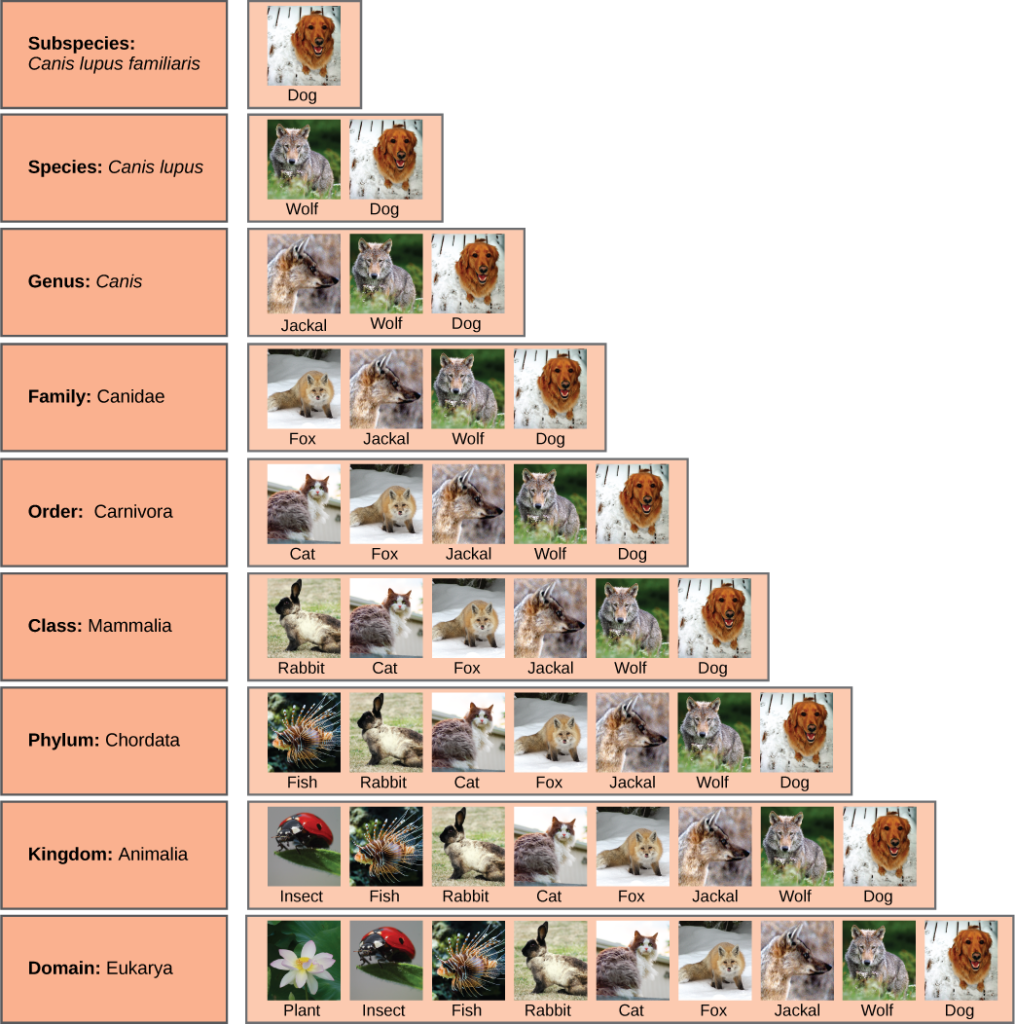How To Draw A Phylogenetic Tree From Dna Sequences
Read and clarify a phylogenetic tree that documents evolutionary relationships
In scientific terms, the evolutionary history and relationship of an organism or group of organisms is called phylogeny. Phylogeny describes the relationships of an organism, such every bit from which organisms information technology is thought to have evolved, to which species it is almost closely related, and so forth. Phylogenetic relationships provide information on shared ancestry simply not necessarily on how organisms are like or dissimilar.
Learning Objectives
- Identify how and why scientists classify the organisms on earth
- Differentiate between types of phylogenetic trees and what their structure tells us
- Identify some limitations of phylogenetic trees
- Relate the taxonomic classification arrangement and binomial classification
Scientific Classification

Figure 1. Just a few of the more than one one thousand thousand known species of insects are represented in this beetle collection. Beetles are a major subgroup of insects. They make up about 40 percent of all insect species and about 25 percent of all known species of organisms.
Why do biologists classify organisms? The major reason is to brand sense of the incredible diversity of life on Earth. Scientists accept identified millions of different species of organisms. Amidst animals, the most diverse grouping of organisms is the insects. More than one million dissimilar species of insects have already been described. An estimated 9 million insect species take yet to be identified. A tiny fraction of insect species is shown in the protrude drove in Figure one.
As various as insects are, there may be even more species of leaner, another major group of organisms. Clearly, there is a demand to organize the tremendous variety of life. Classification allows scientists to organize and meliorate sympathise the bones similarities and differences amidst organisms. This cognition is necessary to sympathise the present diversity and the past evolutionary history of life on World.
Phylogenetic Trees
Scientists utilise a tool called a phylogenetic tree to show the evolutionary pathways and connections among organisms. A phylogenetic tree is a diagram used to reflect evolutionary relationships among organisms or groups of organisms. Scientists consider phylogenetic trees to be a hypothesis of the evolutionary by since one cannot go back to ostend the proposed relationships. In other words, a "tree of life" tin be constructed to illustrate when dissimilar organisms evolved and to prove the relationships among different organisms (Figure ii).
Each group of organisms went through its own evolutionary journey, called its phylogeny. Each organism shares relatedness with others, and based on morphologic and genetic evidence, scientists attempt to map the evolutionary pathways of all life on Globe. Many scientists build phylogenetic trees to illustrate evolutionary relationships.
Construction of Phylogenetic Trees
A phylogenetic tree tin can be read like a map of evolutionary history. Many phylogenetic trees accept a single lineage at the base representing a mutual ancestor. Scientists call such copse rooted, which means there is a single ancestral lineage (typically drawn from the bottom or left) to which all organisms represented in the diagram relate. Notice in the rooted phylogenetic tree that the three domains—Bacteria, Archaea, and Eukarya—diverge from a single point and branch off. The modest co-operative that plants and animals (including humans) occupy in this diagram shows how recent and miniscule these groups are compared with other organisms. Unrooted copse don't show a common antecedent merely practise show relationships amongst species.

Figure 2. Both of these phylogenetic trees shows the relationship of the 3 domains of life—Bacteria, Archaea, and Eukarya—but the (a) rooted tree attempts to identify when various species diverged from a common ancestor while the (b) unrooted tree does not. (credit a: modification of work past Eric Gaba)
In a rooted tree, the branching indicates evolutionary relationships (Figure three). The signal where a split occurs, called abranch bespeak, represents where a single lineage evolved into a distinct new i. A lineage that evolved early from the root and remains unbranched is called basal taxon. When two lineages stem from the aforementioned branch point, they are chosen sister taxa. A co-operative with more than 2 lineages is called a polytomy and serves to illustrate where scientists have not definitively determined all of the relationships. It is important to note that although sister taxa and polytomy do share an ancestor, it does not hateful that the groups of organisms split or evolved from each other. Organisms in two taxa may have divide apart at a specific branch point, but neither taxa gave rising to the other.

Figure 3. The root of a phylogenetic tree indicates that an ancestral lineage gave ascent to all organisms on the tree. A branch indicate indicates where two lineages diverged. A lineage that evolved early and remains unbranched is a basal taxon. When two lineages stem from the same branch bespeak, they are sister taxa. A branch with more than ii lineages is a polytomy.
The diagrams to a higher place can serve equally a pathway to agreement evolutionary history. The pathway can be traced from the origin of life to any individual species by navigating through the evolutionary branches betwixt the two points. Likewise, by starting with a unmarried species and tracing back towards the "trunk" of the tree, one tin observe that species' ancestors, as well every bit where lineages share a mutual ancestry. In addition, the tree can be used to report unabridged groups of organisms.
Another betoken to mention on phylogenetic tree structure is that rotation at branch points does not change the information. For example, if a branch point was rotated and the taxon order inverse, this would not alter the information because the development of each taxon from the co-operative point was contained of the other.
Many disciplines inside the study of biological science contribute to understanding how by and present life evolved over time; these disciplines together contribute to building, updating, and maintaining the "tree of life." Information is used to organize and classify organisms based on evolutionary relationships in a scientific field called systematics. Data may exist collected from fossils, from studying the structure of body parts or molecules used past an organism, and past Dna analysis. By combining data from many sources, scientists tin put together the phylogeny of an organism; since phylogenetic trees are hypotheses, they will continue to change as new types of life are discovered and new information is learned.
Video Review
Limitations of Phylogenetic Copse
It may be easy to assume that more closely related organisms look more alike, and while this is often the case, information technology is not e'er true. If two closely related lineages evolved under significantly varied environment or after the evolution of a major new adaptation, it is possible for the ii groups to appear more different than other groups that are not as closely related. For example, the phylogenetic tree in Figure 4 shows that lizards and rabbits both take amniotic eggs, whereas frogs do not; yet lizards and frogs appear more than similar than lizards and rabbits.

Figure 4. This ladder-like phylogenetic tree of vertebrates is rooted by an organism that lacked a vertebral column. At each branch point, organisms with different characters are placed in different groups based on the characteristics they share.
Another aspect of phylogenetic trees is that, unless otherwise indicated, the branches do not account for length of time, but the evolutionary order. In other words, the length of a branch does not typically mean more time passed, nor does a curt branch mean less time passed— unless specified on the diagram. For example, in Figure 4, the tree does not bespeak how much time passed between the evolution of amniotic eggs and hair. What the tree does testify is the order in which things took place. Again using Figure iv, the tree shows that the oldest trait is the vertebral column, followed by hinged jaws, and so forth. Remember that whatever phylogenetic tree is a part of the greater whole, and like a existent tree, it does not grow in only 1 direction after a new co-operative develops.
So, for the organisms in Figure four, but because a vertebral column evolved does non mean that invertebrate development ceased, it only means that a new branch formed. Also, groups that are non closely related, but evolve under like conditions, may announced more than phenotypically similar to each other than to a close relative.
The Taxonomic Classification Organization
Taxonomy (which literally means "arrangement police force") is the science of classifying organisms to construct internationally shared nomenclature systems with each organism placed into more and more inclusive groupings. Think about how a grocery shop is organized. One large space is divided into departments, such as produce, dairy, and meats. And then each department further divides into aisles, so each alley into categories and brands, and then finally a single product. This organization from larger to smaller, more specific categories is called a hierarchical arrangement.
The taxonomic nomenclature system (also called the Linnaean system after its inventor, Carl Linnaeus, a Swedish botanist, zoologist, and physician) uses a hierarchical model. Moving from the point of origin, the groups get more specific, until one co-operative ends as a single species. For instance, after the common showtime of all life, scientists divide organisms into three large categories chosen a domain: Bacteria, Archaea, and Eukarya. Within each domain is a second category chosen akingdom. Later kingdoms, the subsequent categories of increasing specificity are: phylum, class, order, family, genus, and species (Figure five).

Figure 5. The taxonomic classification organization uses a hierarchical model to organize living organisms into increasingly specific categories. The common domestic dog, Canis lupus familiaris, is a subspecies of Canis lupus, which also includes the wolf and dingo. (credit "domestic dog": modification of piece of work by Janneke Vreugdenhil)
The kingdom Animalia stems from the Eukarya domain. For the common dog, the classification levels would be as shown in Figure v. Therefore, the full name of an organism technically has viii terms. For the dog, it is: Eukarya, Animalia, Chordata, Mammalia, Carnivora, Canidae,Canis, and lupus. Notice that each proper name is capitalized except for species, and the genus and species names are italicized. Scientists generally refer to an organism only by its genus and species, which is its two-word scientific proper name, in what is called binomial nomenclature. Therefore, the scientific name of the dog is Canis lupus. The proper noun at each level is too called a taxon. In other words, dogs are in order Carnivora. Carnivora is the proper name of the taxon at the lodge level; Canidae is the taxon at the family level, and so along. Organisms likewise accept a common proper name that people typically utilize, in this example, dog. Note that the dog is additionally a subspecies: the "familiaris" in Canis lupus familiaris. Subspecies are members of the aforementioned species that are capable of mating and reproducing viable offspring, simply they are considered divide subspecies due to geographic or behavioral isolation or other factors.
Figure 6 shows how the levels move toward specificity with other organisms. Notice how the domestic dog shares a domain with the widest diversity of organisms, including plants and butterflies. At each sublevel, the organisms become more similar because they are more closely related. Historically, scientists classified organisms using characteristics, but as Dna applied science developed, more precise phylogenies take been determined.
Practice Question

Figure 6. At each sublevel in the taxonomic classification system, organisms become more like. Dogs and wolves are the same species considering they tin can breed and produce viable offspring, simply they are different plenty to exist classified as different subspecies. (credit "plant": modification of work past "berduchwal"/Flickr; credit "insect": modification of work by Jon Sullivan; credit "fish": modification of work by Christian Mehlführer; credit "rabbit": modification of work by Aidan Wojtas; credit "cat": modification of work by Jonathan Lidbeck; credit "fob": modification of work by Kevin Bacher, NPS; credit "jackal": modification of work by Thomas A. Hermann, NBII, USGS; credit "wolf": modification of work past Robert Dewar; credit "dog": modification of work by "digital_image_fan"/Flickr)
At what levels are cats and dogs considered to be part of the same group?
Prove Answer
Cats and dogs are part of the aforementioned group at five levels: both are in the domain Eukarya, the kingdom Animalia, the phylum Chordata, the class Mammalia, and the order Carnivora.
Visit this website to classify three organisms—deport, orchid, and sea cucumber—from kingdom to species. To launch the game, under Classifying Life, click the moving-picture show of the bear or the Launch Interactive button.
Recent genetic analysis and other advancements have constitute that some earlier phylogenetic classifications practise non marshal with the evolutionary past; therefore, changes and updates must be made as new discoveries occur. Recall that phylogenetic trees are hypotheses and are modified every bit information becomes bachelor. In add-on, classification historically has focused on grouping organisms mainly by shared characteristics and does not necessarily illustrate how the various groups relate to each other from an evolutionary perspective. For example, despite the fact that a hippopotamus resembles a pig more than a whale, the hippopotamus may be the closest living relative of the whale.
Bank check Your Understanding
Answer the question(southward) below to encounter how well you empathize the topics covered in the previous section. This brusk quiz doesnot count toward your grade in the class, and you can retake it an unlimited number of times.
Use this quiz to bank check your understanding and decide whether to (one) study the previous section further or (2) motility on to the next section.
Source: https://courses.lumenlearning.com/suny-wmopen-biology1/chapter/phylogenetic-trees/
Posted by: talbottume1968.blogspot.com


0 Response to "How To Draw A Phylogenetic Tree From Dna Sequences"
Post a Comment